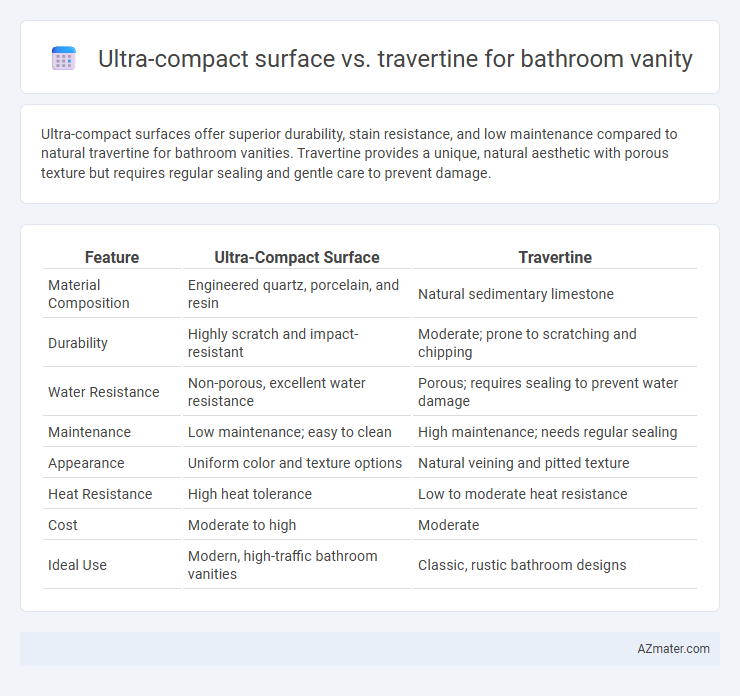Ultra-compact surfaces offer superior durability, stain resistance, and low maintenance compared to natural travertine for bathroom vanities. Travertine provides a unique, natural aesthetic with porous texture but requires regular sealing and gentle care to prevent damage.
Table of Comparison
| Feature | Ultra-Compact Surface | Travertine |
|---|---|---|
| Material Composition | Engineered quartz, porcelain, and resin | Natural sedimentary limestone |
| Durability | Highly scratch and impact-resistant | Moderate; prone to scratching and chipping |
| Water Resistance | Non-porous, excellent water resistance | Porous; requires sealing to prevent water damage |
| Maintenance | Low maintenance; easy to clean | High maintenance; needs regular sealing |
| Appearance | Uniform color and texture options | Natural veining and pitted texture |
| Heat Resistance | High heat tolerance | Low to moderate heat resistance |
| Cost | Moderate to high | Moderate |
| Ideal Use | Modern, high-traffic bathroom vanities | Classic, rustic bathroom designs |
Introduction to Ultra-Compact Surface and Travertine
Ultra-compact surfaces are engineered materials composed of natural minerals like quartz, feldspar, and porcelain, offering exceptional durability, resistance to scratches, stains, and UV exposure, making them ideal for bathroom vanities. Travertine, a natural limestone formed over centuries through mineral deposits in hot springs, features distinctive porous textures and warm earthy tones, lending a classic and elegant aesthetic to bathroom designs. Comparing these materials involves balancing the ultra-compact surface's low maintenance and modern appeal against travertine's natural beauty and need for regular sealing to preserve its integrity.
Material Composition and Structure Comparison
Ultra-compact surfaces, composed of natural minerals combined with high resin content, exhibit exceptional density and water resistance, making them highly durable and non-porous for bathroom vanities. Travertine, a natural sedimentary limestone primarily made of calcite, features a porous structure that requires sealing to prevent water absorption and potential staining in wet environments. The engineered composition of ultra-compact surfaces ensures superior scratch resistance and structural integrity compared to the softer, more porous travertine, which is prone to erosion and surface wear over time.
Aesthetic Appeal: Colors, Patterns, and Style
Ultra-compact surfaces for bathroom vanities offer a sleek, modern aesthetic with a wide range of vibrant colors and intricate patterns, including marble and concrete looks that mimic natural materials without the maintenance. Travertine presents a warm, timeless appeal with its earthy tones and unique, porous texture, delivering a classic and elegant style often associated with luxury bathrooms. Choosing between ultra-compact surfaces and travertine depends on whether a contemporary, versatile design or a natural, sophisticated ambiance is desired.
Durability and Resistance to Daily Wear
Ultra-compact surfaces offer exceptional durability and resistance to daily wear, outperforming travertine in resisting scratches, stains, and moisture commonly found in bathroom environments. Travertine, being a natural stone, is more porous and prone to etching, requiring regular sealing to maintain its surface integrity. Ultra-compact materials provide a non-porous, robust finish ideal for high-traffic bathroom vanities, ensuring long-lasting performance with minimal maintenance.
Maintenance and Cleaning Requirements
Ultra-compact surfaces for bathroom vanities offer exceptional resistance to stains, scratches, and water, requiring minimal maintenance and simple cleaning routines using mild detergents and non-abrasive cloths. Travertine, being a natural stone, is porous and demands regular sealing to prevent water absorption, stains, and damage from acidic cleaners, making its upkeep more labor-intensive and costly. The durability and low maintenance of ultra-compact surfaces make them ideal for busy bathrooms, whereas travertine requires more frequent attention to preserve its aesthetic and structural integrity.
Moisture and Stain Resistance Performance
Ultra-compact surfaces, engineered with high-density materials, exhibit exceptional moisture resistance, preventing water absorption and reducing the risk of mold or deterioration common in bathroom environments. Travertine, a natural stone, is porous and prone to staining and moisture penetration unless sealed regularly, making it less ideal in spaces with high humidity. The superior non-porous nature of ultra-compact surfaces ensures enhanced durability and easier maintenance compared to the more vulnerable and porous travertine.
Installation Process and Flexibility
Ultra-compact surfaces offer a streamlined installation process due to their lightweight and uniform thickness, allowing for easy cutting and shaping, which reduces labor time and complexity. Travertine requires more careful handling and precise cutting because of its natural stone texture and variable thickness, making installation more labor-intensive and less flexible in design adaptation. The flexibility of ultra-compact surfaces supports installation in tight or uniquely shaped spaces, while travertine's rigidity can limit customization and requires additional structural support.
Cost Analysis: Upfront and Long-Term Value
Ultra-compact surfaces for bathroom vanities typically present a higher upfront cost, ranging from $70 to $100 per square foot, compared to travertine, which averages $40 to $70 per square foot, making travertine initially more budget-friendly. Long-term value favors ultra-compact materials due to their superior durability, resistance to stains and scratches, and minimal maintenance requirements, which reduce replacement and repair expenses over time. Travertine, while aesthetically appealing and often chosen for natural stone texture, incurs higher long-term costs related to sealing, cleaning, and vulnerability to etching and cracking in wet environments.
Eco-Friendliness and Sustainability
Ultra-compact surfaces for bathroom vanities are highly eco-friendly due to their low energy consumption in production and long-lasting durability, reducing the need for frequent replacements. Travertine, a natural stone, offers sustainability through its natural origins and biodegradability, but quarrying processes may have higher environmental impacts. Choosing ultra-compact surfaces aligns with modern sustainable practices by minimizing resource use and supporting waste reduction.
Best Uses and Design Recommendations for Each Material
Ultra-compact surfaces offer exceptional durability, scratch resistance, and minimal porosity, making them ideal for high-traffic bathroom vanities in contemporary and minimalist designs that emphasize sleek, seamless aesthetics. Travertine provides a natural, warm appearance with unique veining patterns suited for classic, rustic, or Mediterranean-style bathrooms where a luxurious, textured stone look enhances the overall design. For best results, ultra-compact materials perform well in moisture-prone areas requiring easy maintenance, while travertine benefits from sealed protection and can be paired with softer lighting to highlight its natural beauty.

Infographic: Ultra-compact surface vs Travertine for Bathroom Vanity
 azmater.com
azmater.com